| dc.description.abstract | As a consequence of the increasing human footprint on the environment, marine ecosystems are rapidly transforming into new configurations dominated by early-successional and weedy life forms. Algal turfs, in particular, are emerging as a common and widespread configuration of shallow temperate and tropical reefs, and are predicted to transform reef dynamics and ecosystem services. Restoration is an increasingly used approach to mitigate these transformations, with turf removal being proposed as a tool to shift back the competitive balance and facilitate the recovery of initial species, such as forest-forming seaweeds. Yet, our practical understanding of turf recovery trajectories following removal is limited, and removal success may be hindered by strong feedback mechanisms that reinforce turf dominance once turfs are established. Here we investigate the recovery of algal turfs and their properties (mean height, turf biomass and sediment load) to experimental clearance across six turf-dominated reefs at ca. 9 m in subtropical western Australia. Turf cover, mean height, and sediment loads exhibited a rapid recovery following experimental clearing, with all experimental sites reaching pre-clearing turf conditions between 28 and 46 days. This response was mostly driven by the growth of filamentous turf species, whose cover exhibited a positive relationship with sediment load, and are well-known to rapidly recover after disturbance. Turf abundance and turf properties remained relatively constant for the remaining experimental period. Our results suggest that clearing turfs creates only a small time window for recovery of seaweed forests, which limits the effectiveness of turf clearing as a restoration tool. System-specific quantitative evidence on the recovery capacity of turfs may thus be necessary to guide restoration initiatives and develop decision support systems that account for the risks, feasibility, and costs and benefits of restoring turf-dominated systems to previous configurations. | en_US |
